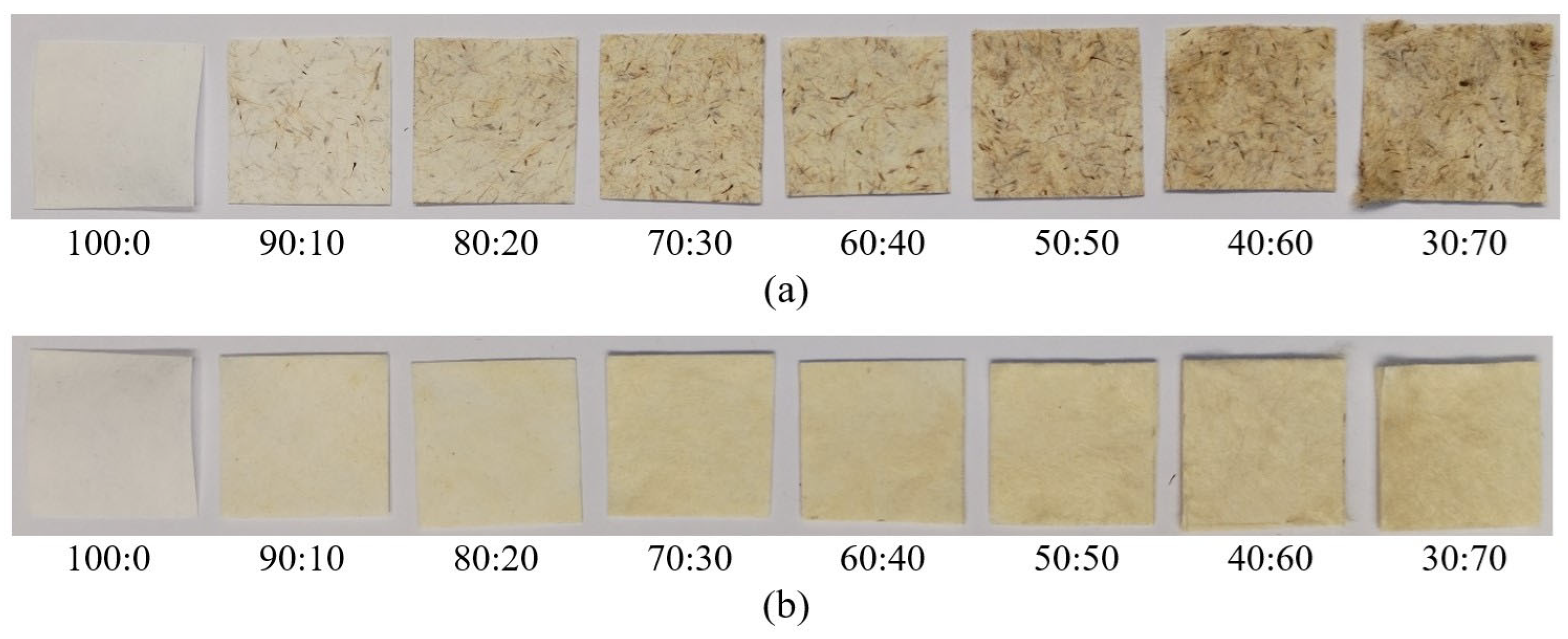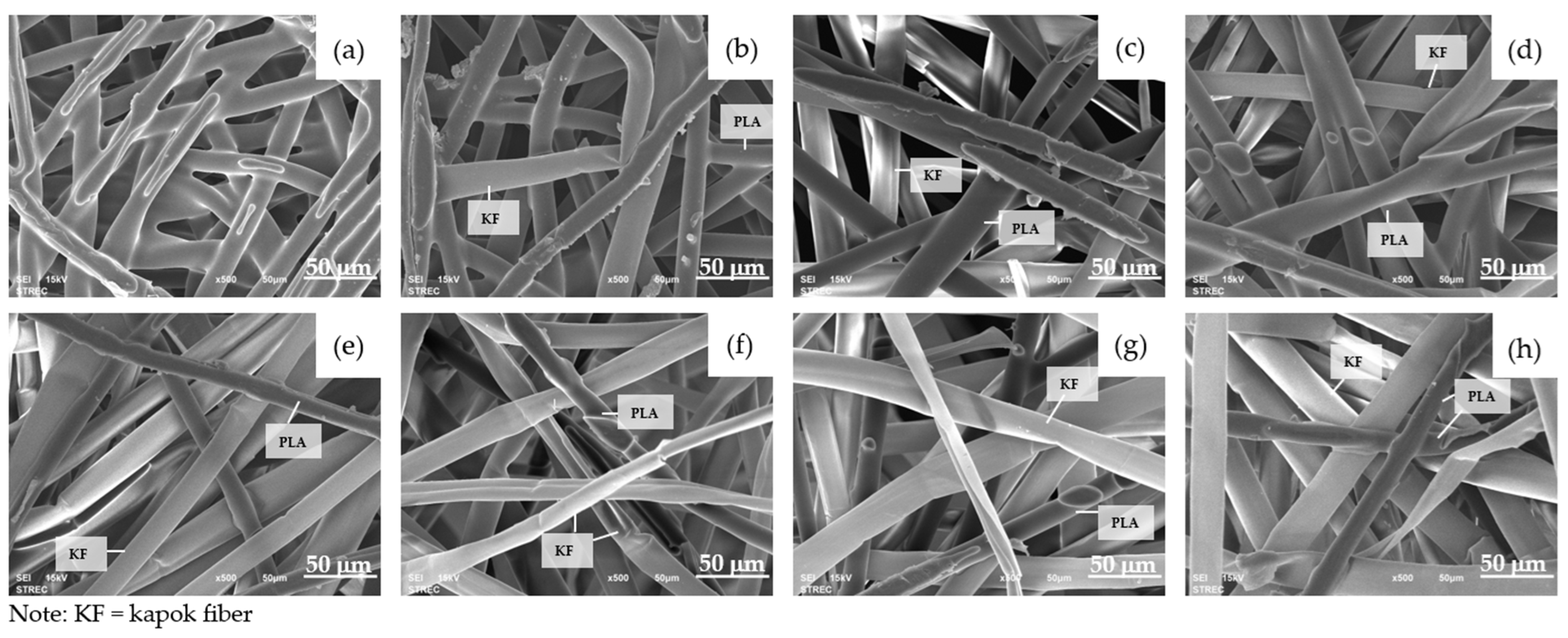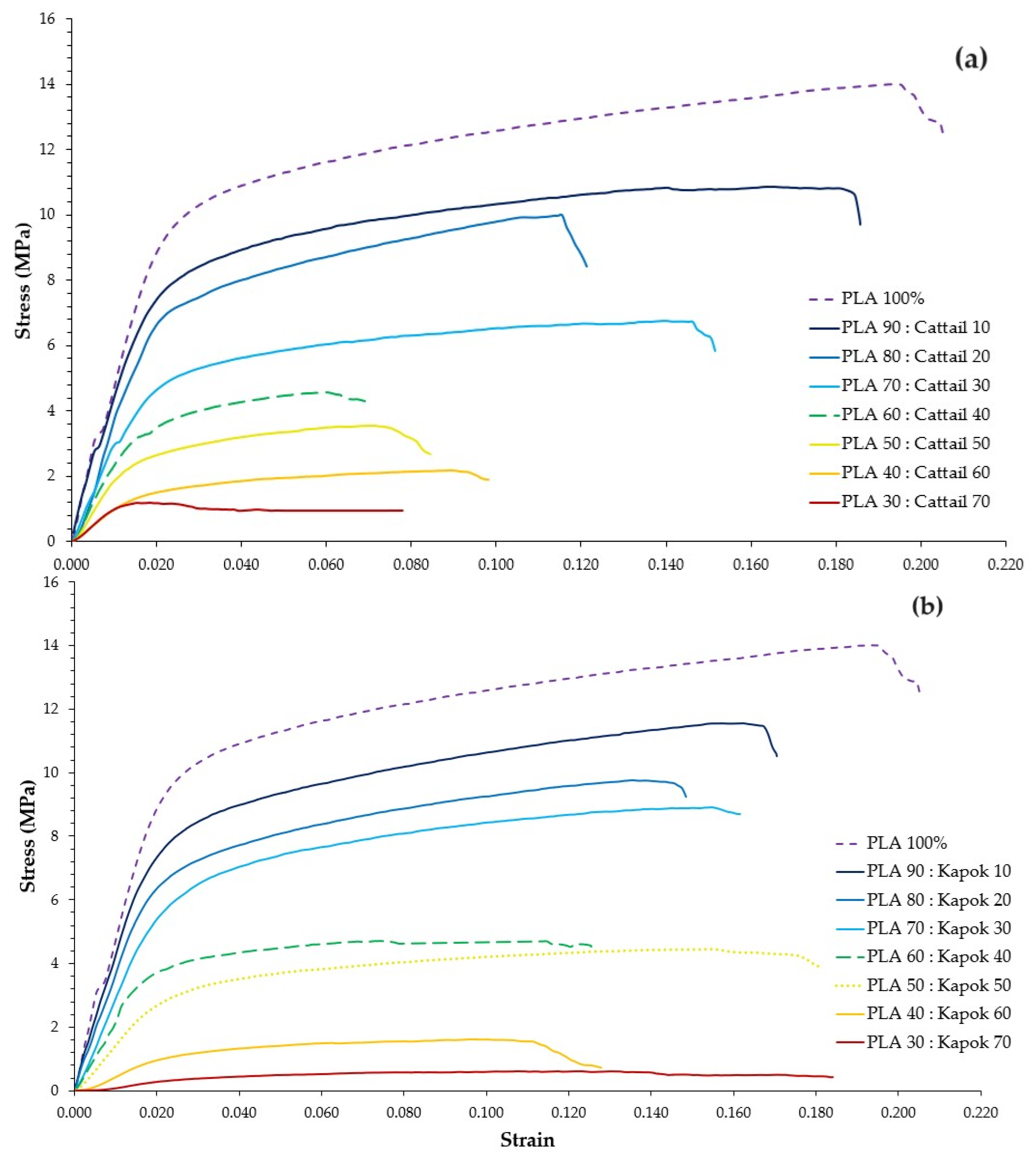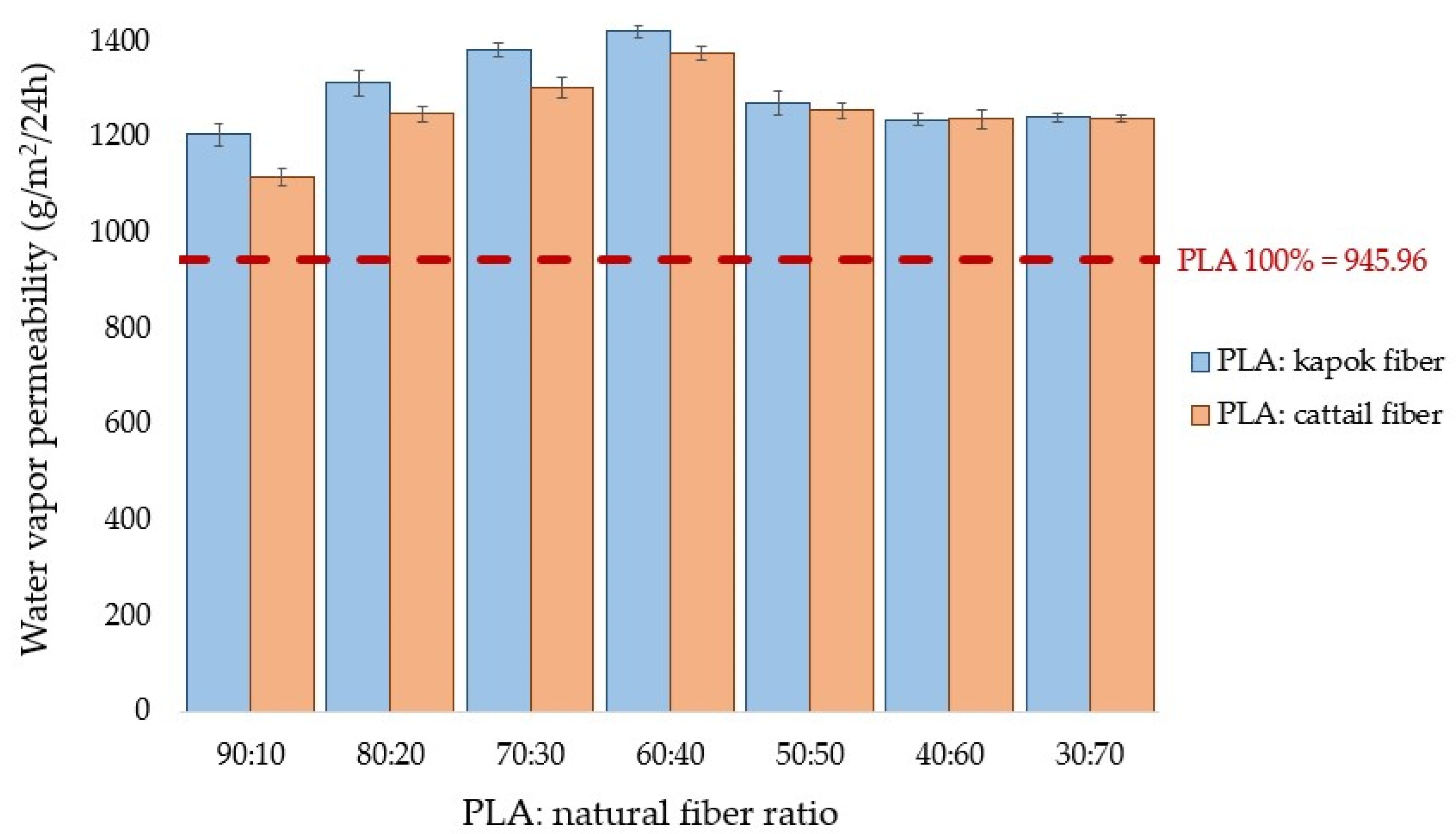Utilization of Waste Natural Fibers Mixed with Polylactic Acid (PLA) Bicomponent Fiber: Incorporating Kapok and Cattail Fibers for Nonwoven Medical Textile Applications
Abstract
:1. Introduction
2. Materials and Methods
2.1. Materials
2.2. Preparation of Natural Fibers/Polylactic Acid Bicomponent Fiber Composite Webs
2.3. Characterizations
2.4. Properties
2.4.1. Color Measurement
2.4.2. Contact Angle Measurements
2.4.3. Antibacterial Activity
- R is the percentage of reduction bacteria viability;
- C0 is the number of bacteria colonies at contact time = 0 h;
- C is the number of bacteria colonies after contact time.
2.4.4. Mechanical Test
2.4.5. Water Vapor Permeability Analysis
- M is the loss in mass (g) of water vapor through the fabric specimen;
- A is the internal area of the dish (m2);
- T is the time between weighing (h).
2.5. Statistical Analysis
3. Results and Discussion
3.1. Characterization of Fibers
3.2. Characterization of Composite Webs
3.2.1. Thickness
3.2.2. Color Measurement
3.2.3. Morphology of Composite Webs
3.2.4. Mechanical Test
3.2.5. Water Contact Angle Measurement
3.2.6. Water Vapor Permeability Analysis
4. Conclusions
Author Contributions
Funding
Institutional Review Board Statement
Data Availability Statement
Conflicts of Interest
References
- Benson, N.U.; Bassey, D.E.; Palanisami, T. COVID Pollution: Impact of COVID-19 Pandemic on Global Plastic Waste Footprint. Heliyon 2021, 7, e06343. [Google Scholar] [CrossRef] [PubMed]
- Wang, L.; Li, S.; Ahmad, I.M.; Zhang, G.; Sun, Y.; Wang, Y.; Sun, C.; Jiang, C.; Cui, P.; Li, D. Global Face Mask Pollution: Threats to the Environment and Wildlife, and Potential Solutions. Sci. Total Environ. 2023, 887, 164055. [Google Scholar] [CrossRef] [PubMed]
- Cubas, A.L.V.; Moecke, E.H.S.; Provin, A.P.; Dutra, A.R.A.; Machado, M.M.; Gouveia, I.C. The Impacts of Plastic Waste from Personal Protective Equipment Used during the COVID-19 Pandemic. Polymers 2023, 15, 3151. [Google Scholar] [CrossRef] [PubMed]
- Singh, N.; Ogunseitan, O.A.; Wong, M.H.; Tang, Y. Sustainable Materials Alternative to Petrochemical Plastics Pollution: A Review Analysis. Sustain. Horiz. 2022, 2, 100016. [Google Scholar] [CrossRef]
- Mangal, M.; Rao, C.V.; Banerjee, T. Bioplastic: An Eco-Friendly Alternative to Non-Biodegradable Plastic. Polym. Int. 2023, 72, 984–996. [Google Scholar] [CrossRef]
- Jawahar, V.; Gabriel, M.; Santhanam, S.; Selvaraj, S.K. Sustainable Waste Cotton and Pigeon Pea Stalk Fibers Composite Materials for Acoustics and Thermal Properties. J. Eng. Fibers Fabr. 2023, 18, 1–9. [Google Scholar] [CrossRef]
- Maiti, S.; Islam, M.R.; Uddin, M.A.; Afroj, S.; Eichhorn, S.J.; Karim, N. Sustainable Fiber-Reinforced Composites: A Review. Adv. Sustain. Syst. 2022, 6, 2200258. [Google Scholar] [CrossRef]
- Mula, M.; Tekbaş, R.N.; Cengiz, F.; Yüksek, İ.Ö.; Gürarslan, A. Sustainable Milkweed Fiber Composites for Medical Textile Application. ACS Sustain. Chem. Eng. 2023, 11, 12523–12531. [Google Scholar] [CrossRef]
- Fages, E.; Gironés, S.; Sánchez-Nacher, L.; García-Sanoguera, D.; Balart, R. Use of Wet-Laid Techniques to Form Flax-Polypropylene Nonwovens as Base Substrates for Eco-Friendly Composites by Using Hot-Press Molding. Polym. Compos. 2012, 33, 253–261. [Google Scholar] [CrossRef]
- Ghali, L.; Halimi, M.T.; Hassen, M.B.; Sakli, F. Effect of Blending Ratio of Fibers on the Properties of Nonwoven Fabrics Based of Alfa Fibers. Adv. Mater. Phys. Chem. 2014, 4, 116–125. [Google Scholar] [CrossRef]
- Möhl, C.; Weimer, T.; Caliskan, M.; Baz, S.; Bauder, H.-J.; Gresser, G.T. Development of Natural Fibre-Reinforced Semi-Finished Products with Bio-Based Matrix for Eco-Friendly Composites. Polymers 2022, 14, 698. [Google Scholar] [CrossRef] [PubMed]
- Cui, F.; Li, H.; Chen, C.; Wang, Z.; Liu, X.; Jiang, G.; Cheng, T.; Bai, R.; Song, L. Cattail Fibers as Source of Cellulose to Prepare a Novel Type of Composite Aerogel Adsorbent for the Removal of Enrofloxacin in Wastewater. Int. J. Biol. Macromol. 2021, 191, 171–181. [Google Scholar] [CrossRef] [PubMed]
- Zheng, Y.; Wang, J.; Zhu, Y.; Wang, A. Research and Application of Kapok Fiber as an Absorbing Material: A Mini Review. J. Environ. Sci. 2015, 27, 21–32. [Google Scholar] [CrossRef] [PubMed]
- Zerga, A.Y.; Tahir, M. Biobased Kapok Fiber Nano-Structure for Energy and Environment Application: A Critical Review. Molecules 2022, 27, 8107. [Google Scholar] [CrossRef] [PubMed]
- Zhang, J.; Yan, X.; Cao, S.; Xu, G. Morphological Characterization and Properties of Cattail Fibers. Mater. Tehnol. 2018, 52, 625–631. [Google Scholar] [CrossRef]
- Xu, Y.; Shen, H.; Xu, G. Evaluation of Oil Sorption Kinetics Behavior and Wetting Characteristic of Cattail Fiber. Cellulose 2020, 27, 1531–1541. [Google Scholar] [CrossRef]
- Song, G.G.; Yang, J.; Liu, K.X.; Qin, Z.; Zheng, X.C. Cattail Fiber-Derived Hierarchical Porous Carbon Materials for High-Performance Supercapacitors. Diam. Relat. Mater. 2021, 111, 108162. [Google Scholar] [CrossRef]
- Li, H.; Song, L.; Huo, D.; Yang, Y.; Zhang, N.; Liang, J. Cattail-Grass-Derived Porous Carbon as High-Capacity Anode Material for Li-Ion Batteries. Molecules 2023, 28, 4427. [Google Scholar] [CrossRef]
- Sangalang, R. Kapok Fiber- Structure, Characteristics and Applications: A Review. Orient. J. Chem. 2021, 37, 513–523. [Google Scholar] [CrossRef]
- Cao, L.; Xu, Y.; Xie, K.; Wang, F.; Xu, G. The Wettability and Micro-Equilibrium of Different Essence Liquids to Alkali-Treated Kapok Fiber. Text. Res. J. 2022, 92, 860–870. [Google Scholar] [CrossRef]
- Dong, T.; Cao, S.; Xu, G. Highly Efficient and Recyclable Depth Filtrating System Using Structured Kapok Filters for Oil Removal and Recovery from Wastewater. J. Hazard. Mater. 2017, 321, 859–867. [Google Scholar] [CrossRef] [PubMed]
- Wang, H.; Cao, L.; Yuan, H.; Li, Y.; Wen, R.; Xu, G. Development and Characterization of Kapok/Waste Silk Nonwoven as a Multifunctional Bio-Based Material for Textile Applications. J. Ind. Text. 2023, 53, 1–33. [Google Scholar] [CrossRef]
- Ilyas, R.A.; Sapuan, S.M.; Harussani, M.M.; Hakimi, M.Y.A.Y.; Haziq, M.Z.M.; Atikah, M.S.N.; Asyraf, M.R.M.; Ishak, M.R.; Razman, M.R.; Nurazzi, N.M.; et al. Polylactic Acid (PLA) Biocomposite: Processing, Additive Manufacturing and Advanced Applications. Polymers 2021, 13, 1326. [Google Scholar] [CrossRef] [PubMed]
- Wu, Y.; Gao, X.; Wu, J.; Zhou, T.; Nguyen, T.T.; Wang, Y. Biodegradable Polylactic Acid and Its Composites: Characteristics, Processing, and Sustainable Applications in Sports. Polymers 2023, 15, 3096. [Google Scholar] [CrossRef] [PubMed]
- Shao, L.; Xi, Y.; Weng, Y. Recent Advances in PLA-Based Antibacterial Food Packaging and Its Applications. Molecules 2022, 27, 5953. [Google Scholar] [CrossRef] [PubMed]
- Pérez-Davila, S.; González-Rodríguez, L.; Lama, R.; López-Álvarez, M.; Oliveira, A.L.; Serra, J.; Novoa, B.; Figueras, A.; González, P. 3D-Printed PLA Medical Devices: Physicochemical Changes and Biological Response after Sterilisation Treatments. Polymers 2022, 14, 4117. [Google Scholar] [CrossRef] [PubMed]
- Eutionnat-Diffo, P.A.; Chen, Y.; Guan, J.; Cayla, A.; Campagne, C.; Zeng, X.; Nierstrasz, V. Stress, Strain and Deformation of Poly-Lactic Acid Filament Deposited onto Polyethylene Terephthalate Woven Fabric through 3D Printing Process. Sci. Rep. 2019, 9, 14333. [Google Scholar] [CrossRef]
- Spahiu, T.; Canaj, E.; Shehi, E. 3D Printing for Clothing Production. J. Eng. Fibers Fabr. 2020, 15, 1–8. [Google Scholar] [CrossRef]
- Kalita, N.K.; Damare, N.A.; Hazarika, D.; Bhagabati, P.; Kalamdhad, A.; Katiyar, V. Biodegradation and Characterization Study of Compostable PLA Bioplastic Containing Algae Biomass as Potential Degradation Accelerator. Environ. Chall. 2021, 3, 100067. [Google Scholar] [CrossRef]
- Buddhakala, M.; Buddhakala, N. Physical, Mechanical and Antibacterial Properties of Biodegradable Bioplastics from Polylactic Acid and Corncob Fibers with Added Nano Titanium Dioxide. Trends Sci. 2023, 20, 6473. [Google Scholar] [CrossRef]
- ASTM E2149-20; Standard Test Method for Determining the Antimicrobial Activity of Antimicrobial Agents under Dynamic Contact Conditions. ASTM: West Conshohocken, PA, USA, 2020.
- BS 7209; Water Vapour Permeable Apparel Fabrics. BS: London, UK, 1990.
- Unterweger, C.; Mayrhofer, T.; Piana, F.; Duchoslav, J.; Stifter, D.; Poitzsch, C.; Fürst, C. Impact of Fiber Length and Fiber Content on the Mechanical Properties and Electrical Conductivity of Short Carbon Fiber Reinforced Polypropylene Composites. Compos. Sci. Technol. 2022, 188, 107998. [Google Scholar] [CrossRef]
- Tsioptsias, C.; Tsivintzelis, I. On the Thermodynamic Thermal Properties of Quercetin and Similar Pharmaceuticals. Molecules 2022, 27, 6630. [Google Scholar] [CrossRef] [PubMed]
- Syed Draman, S.F.; Daik, R.; Abdul Latif, F.; El-Sheikh, S.M. Characterization and Thermal Decomposition Kinetics of Kapok (Ceiba pentandra L.)–Based Cellulose. BioResources 2013, 9, 8–23. [Google Scholar] [CrossRef]
- Neto, J.S.S.; de Queiroz, H.F.M.; Aguiar, R.A.A.; Banea, M.D. A Review on the Thermal Characterisation of Natural and Hybrid Fiber Composites. Polymers 2021, 13, 4425. [Google Scholar] [CrossRef] [PubMed]
- Karvran, M.; Vagner, C.; Cochez, M.; Ponçot, M.; Saeb, M.R.; Vahabi, H. Thermal Degradation of Polylactic Acid (PLA)/Polyhydroxybutyrate (PHB) Blends: A Systematic Review. Polym. Degrad. Stab. 2022, 201, 109995. [Google Scholar] [CrossRef]
- Du, Q.; Chen, Y.N. R & D Status and Countermeasures of Natural Functional Kapok Fiber. Adv. Mater. Res. 2013, 796, 199–204. [Google Scholar] [CrossRef]
- Hu, L.; Wang, F.; Xu, G.; Xu, B. Unique Microstructure of Kapok Fibers in Longitudinal Microscopic Images. Text. Res. J. 2017, 87, 2255–2262. [Google Scholar] [CrossRef]
- Koschevic, M.T.; Araújo, R.P.; Garcia, V.A.; Fakhouri, F.M.; Oliveira, K.M.P.; Arruda, E.J.; Dufresne, A.; Martelli, S.M. Antimicrobial Activity of Bleached Cattail Fibers (Typha domingensis) Impregnated with Silver Nanoparticles and Benzalkonium Chloride. J. Appl. Polym. Sci. 2021, 138, 50885. [Google Scholar] [CrossRef]
- Mwaikambo, L.Y. Review of the History, Properties and Application of Plant Fibres. Afr. J. Sci. Technol. 2006, 7, 120–133. [Google Scholar]
- Sekar, V.; Fouladi, M.H.; Namasivayam, S.N.; Sivanesan, S. Additive Manufacturing: A Novel Method for Developing an Acoustic Panel Made of Natural Fiber-Reinforced Composites with Enhanced Mechanical and Acoustical Properties. J. Eng. 2019, 2019, 4546863. [Google Scholar] [CrossRef]
- Wu, S.; Zhang, J.; Li, C.; Wang, F.; Shi, L.; Tao, M.; Weng, B.; Yan, B.; Guo, Y.; Chen, Y. Characterization of Potential Cellulose Fiber from Cattail Fiber: A Study on Micro/Nano Structure and Other Properties. Int. J. Biol. Macromol. 2021, 193, 27–37. [Google Scholar] [CrossRef] [PubMed]
- Dolza, C.; Gonga, E.; Fages, E.; Tejada-Oliveros, R.; Balart, R.; Quiles-Carrillo, L. Green Composites from Partially Bio-Based Poly(butylene succinate-co-adipate)-PBSA and Short Hemp Fibers with Itaconic Acid-Derived Compatibilizers and Plasticizers. Polymers 2022, 14, 1968. [Google Scholar] [CrossRef] [PubMed]
- Jamat, M.D.; Asik, J. Performance of Kapok Fiber Reinforced Polyvinyl Alcohol Biocomposite by Alkali treated. Borneo J. Resour. Sci. Technol. 2019, 40, 38–50. [Google Scholar]
- Lee, S.K.; Cho, D.; Park, W.H.; Lee, S.G.; Han, S.O.; Drzal, L.T. Novel Silk/Poly(Butylene Succinate) Biocomposites: The Effect of Short Fibre Content on their Mechanical and Thermal Properties. Compos. Sci. Technol. 2005, 65, 647–657. [Google Scholar] [CrossRef]
- Du, B.; Li, Z.; Bai, H.; Li, Q.; Zheng, C.; Liu, J.; Qiu, F.; Fan, Z.; Hu, H.; Chen, L. Mechanical Property of Long Glass Fiber Reinforced Polypropylene Composite: From Material to Car Seat Frame and Bumper Beam. Polymers 2022, 14, 1814. [Google Scholar] [CrossRef] [PubMed]
- EN 13795; Surgical Clothing and Drapes—Requirements and Test Methods—Part 1: Surgical Drapes and Gowns. EN: Brussels, Belgium, 2019.
- Lim, T.T.; Huang, X. Evaluation of Hydrophobicity/Oleophilicity of Kapok and Its Performance in Oily Water Filtration: Comparison of Raw and Solvent-Treated Fibers. Ind. Crops Prod. 2007, 26, 125–134. [Google Scholar] [CrossRef]
- Futalan, C.M.; Choi, A.E.S.; Soriano, H.G.O.; Cabacungan, M.K.B.; Millare, J.C. Modification Strategies of Kapok Fiber Composites and Its Application in the Adsorption of Heavy Metal Ions and Dyes from Aqueous Solutions: A Systematic Review. Int. J. Environ. Res. Public Health. 2022, 19, 2703. [Google Scholar] [CrossRef]
- Cui, Y.; Xu, G.; Liu, Y. Oil Sorption Mechanism and Capacity of Cattail Fiber Assembly. J. Ind. Text. 2014, 43, 330–337. [Google Scholar] [CrossRef]
- Abdullah, M.A.; Rahmah, A.U.; Man, Z. Physicochemical and Sorption Characteristics of Malaysian Ceiba pentandra (L.) Gaertn. as a Natural Oil Sorbent. J. Hazard Mater. 2010, 177, 683–691. [Google Scholar] [CrossRef]
- Behera, B.K.; Arora, H. Surgical Gown: A Critical Review. J. Ind. Text. 2009, 38, 205–231. [Google Scholar] [CrossRef]
- Baraniak, J.; Kania-Dobrowolska, M. Multi-Purpose Utilization of Kapok Fiber and Properties of Ceiba Pentandra Tree in Various Branches of Industry. J. Nat. Fibers 2023, 20, 2192542. [Google Scholar] [CrossRef]
- Kannekens, A. Breathable Coatings and Laminates. J. Coat. Fabr. 1994, 24, 51–59. [Google Scholar] [CrossRef]








| Type of Bacteria | Bacterial Reduction (%) | ||
|---|---|---|---|
| Cattail Fiber | Kapok Fiber | PLA Bicomponent Fiber | |
| S. aureus | 7.78 | 16.73 | 1.41 |
| K. pneumoniae | −8.25 | −6.98 | −7.51 |
| PLA: Natural Fiber Ratio | Thickness (mm) | |
|---|---|---|
| PLA: Cattail Fiber | PLA: Kapok Fiber | |
| 100:0 | 0.2594 ± 0.0328 bcdefgh | 0.2594 ± 0.0328 bcdefgh |
| 90:10 | 0.3436 ± 0.0365 adefgh | 0.3798 ± 0.0188 aefgh |
| 80:20 | 0.3606 ± 0.0211 aefgh | 0.3812 ± 0.0160 aefgh |
| 70:30 | 0.4080 ± 0.0424 abefgh | 0.4268 ± 0.0393 aefgh |
| 60:40 | 0.4686 ± 0.0165 abcdfgh | 0.5024 ± 0.0352 abcdgh |
| 50:50 | 0.5288 ± 0.0190 abcde | 0.5648 ± 0.0502 abcdh |
| 40:60 | 0.5468 ± 0.0340 abcde | 0.7020 ± 0.1192 abcde |
| 30:70 | 0.6286 ± 0.1049 abcde | 0.8252 ± 0.1309 abcdef |
| PLA: Natural Fiber Ratio | PLA: Cattail Fiber | PLA: Kapok Fiber | ||||||
|---|---|---|---|---|---|---|---|---|
| WI 1 | L* | a* | b* | WI 1 | L* | a* | b* | |
| 100:0 | 86.49 | 94.71 | −0.20 | 0.08 | 86.49 | 94.71 | −0.20 | 0.08 |
| 90:10 | 44.98 | 87.09 | 1.71 | 4.89 | 48.54 | 90.12 | −0.18 | 6.31 |
| 80:20 | 32.86 | 85.35 | 1.58 | 6.86 | 34.28 | 88.87 | 1.09 | 8.13 |
| 70:30 | 13.84 | 84.00 | 2.36 | 7.38 | 21.77 | 87.69 | 1.49 | 10.07 |
| 60:40 | −6.86 | 76.90 | 2.78 | 9.74 | 16.85 | 86.85 | 1.81 | 10.60 |
| 50:50 | −21.85 | 74.04 | 3.84 | 11.05 | 7.02 | 85.68 | 2.23 | 11.94 |
| 40:60 | −61.94 | 71.31 | 5.15 | 16.08 | −3.17 | 84.38 | 2.46 | 13.25 |
| 30:70 | −57.00 | 70.48 | 5.29 | 16.52 | −4.38 | 83.20 | 2.29 | 13.47 |
| Sample | PLA: Natural Fiber | Ultimate Load (N) | Young’s Modulus (MPa) | Elongation at Break (%) | Yield Strength (MPa) | Yield Strain (%) |
|---|---|---|---|---|---|---|
| 100:0 | 47.08 ± 2.01 abcdef | 551.76 ± 10.75 abcdefg | 8.17 ± 0.64 abcdef | 10.62 ± 0.90 abcde | 5.99 ± 0.14 abcdef | |
| PLA: cattail fiber | 90:10 | 42.19 ± 3.91 abcde | 523.71 ± 6.11 abcdefh | 7.90 ± 0.46 abcdef | 10.85 ± 0.65 abcdef | 5.84 ± 0.07 abcde |
| 80:20 | 33.95 ± 0.75 abcdegh | 470.29 ± 12.25 abcdegh | 4.07 ± 0.24 gh | 8.71 ± 0.22 abcdefh | 4.79 ± 0.50 abcdh | |
| 70:30 | 21.18 ± 2.53 abcdfgh | 309.72 ± 12.11 abcdfgh | 4.33 ± 1.47 gh | 4.44 ± 0.80 abcfgh | 3.91 ± 0.45 adgh | |
| 60:40 | 15.10 ± 0.88 abcefgh | 279.23 ± 13.57 abcefgh | 3.26 ± 0.96 gh | 3.70 ± 0.43 abcfgh | 2.33 ± 0.97 fgh | |
| 50:50 | 7.23 ± 0.68 defgh | 153.95 ± 13.45 abdefgh | 3.68 ± 0.89 gh | 1.84 ± 0.08 defgh | 2.75 ± 0.40 efgh | |
| 40:60 | 7.01 ± 0.87 defgh | 115.84 ± 8.14 cdefgh | 3.36 ± 0.78 gh | 1.63 ± 0.22 defgh | 2.68 ± 0.71 fgh | |
| 30:70 | 6.02 ± 0.79 defgh | 117.28 ± 10.44 cdefgh | 3.64 ± 0.60 gh | 1.41 ± 0.22 defgh | 2.11 ± 0.52 efgh | |
| 100:0 | 47.08 ± 2.01 abcdef | 551.76 ± 10.75 abcdefg | 8.17 ± 0.64 abcdfh | 10.62 ± 0.90 abcde | 5.99 ± 0.14 abcdfg | |
| PLA: kapok fiber | 90:10 | 45.48 ± 2.85 abcde | 451.37 ± 35.69 abcdeh | 6.79 ± 0.24 acgh | 9.43 ± 1.22 abcdeh | 4.37 ± 0.62 abcdf |
| 80:20 | 39.88 ± 3.08 abcdeh | 408.35 ± 23.61 abcdeh | 6.42 ± 0.31 acgh | 10.83 ± 0.57 abcdef | 4.76 ± 0.65 abcdh | |
| 70:30 | 22.46 ± 1.58 abdfgh | 295.28 ± 48.84 abdfgh | 6.55 ± 0.81 ach | 7.10 ± 1.52 abdfgh | 4.51 ± 0.84 aceh | |
| 60:40 | 18.13 ± 2.16 abefgh | 224.79 ± 35.02 abefgh | 3.96 ± 1.46 gh | 3.82 ± 0.22 abdfgh | 2.67 ± 0.97 egh | |
| 50:50 | 15.81 ± 0.19 abfgh | 170.42 ± 14.75 abfgh | 4.45 ± 0.65 defgh | 3.85 ± 0.93 cefgh | 2.56 ± 0.72 eghf | |
| 40:60 | 8.44 ± 0.12 acdefgh | 129.35 ± 1.83 acdefgh | 3.67 ± 0.48 defgh | 1.85 ± 0.29 cefgh | 2.16 ± 0.74 egh | |
| 30:70 | 1.59 ± 0.03 bcdefgh | 21.73 ± 6.72 bcdefgh | 9.77 ± 0.01 abcdefg | 0.25 ± 0.01 cefgh | 1.87 ± 0.34 efgh |
Disclaimer/Publisher’s Note: The statements, opinions and data contained in all publications are solely those of the individual author(s) and contributor(s) and not of MDPI and/or the editor(s). MDPI and/or the editor(s) disclaim responsibility for any injury to people or property resulting from any ideas, methods, instructions or products referred to in the content. |
© 2023 by the authors. Licensee MDPI, Basel, Switzerland. This article is an open access article distributed under the terms and conditions of the Creative Commons Attribution (CC BY) license (https://creativecommons.org/licenses/by/4.0/).
Share and Cite
Srisuk, T.; Charoenlarp, K.; Kampeerapappun, P. Utilization of Waste Natural Fibers Mixed with Polylactic Acid (PLA) Bicomponent Fiber: Incorporating Kapok and Cattail Fibers for Nonwoven Medical Textile Applications. Polymers 2024, 16, 76. https://doi.org/10.3390/polym16010076
Srisuk T, Charoenlarp K, Kampeerapappun P. Utilization of Waste Natural Fibers Mixed with Polylactic Acid (PLA) Bicomponent Fiber: Incorporating Kapok and Cattail Fibers for Nonwoven Medical Textile Applications. Polymers. 2024; 16(1):76. https://doi.org/10.3390/polym16010076
Chicago/Turabian StyleSrisuk, Tanyalak, Khanittha Charoenlarp, and Piyaporn Kampeerapappun. 2024. "Utilization of Waste Natural Fibers Mixed with Polylactic Acid (PLA) Bicomponent Fiber: Incorporating Kapok and Cattail Fibers for Nonwoven Medical Textile Applications" Polymers 16, no. 1: 76. https://doi.org/10.3390/polym16010076
APA StyleSrisuk, T., Charoenlarp, K., & Kampeerapappun, P. (2024). Utilization of Waste Natural Fibers Mixed with Polylactic Acid (PLA) Bicomponent Fiber: Incorporating Kapok and Cattail Fibers for Nonwoven Medical Textile Applications. Polymers, 16(1), 76. https://doi.org/10.3390/polym16010076






